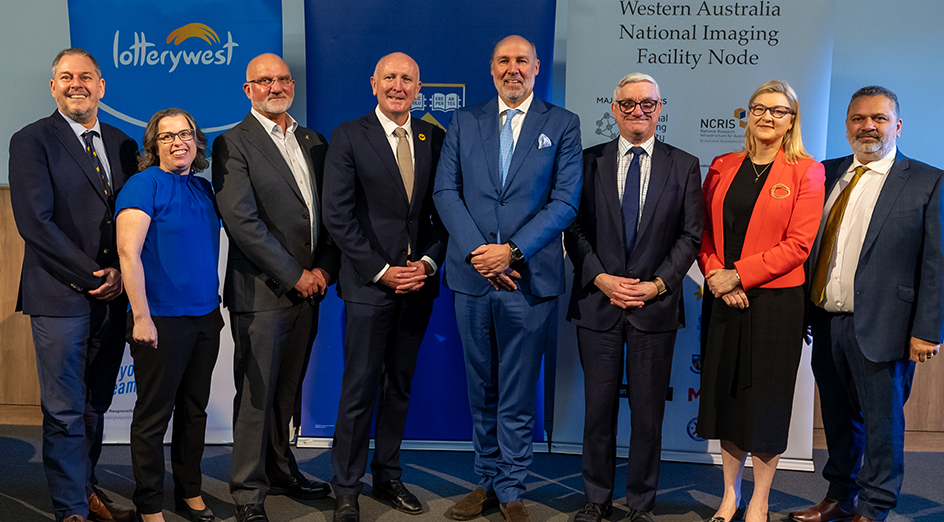A new multimillion dollar imaging facility that will underpin Western Australia’s access to potentially life-changing clinical trials in neuroscience, cancer and a new generation of technologies was launched today by Science and Medical Research Minister Stephen Dawson.
“The scanners will cover a broad scope of diseases and treatment needs from basic science through to clinical trials – and will be available to all WA researchers.”
Professor Amit Chakma, UWA Vice-Chancellor
The WA ³Ô¹ÏÍøÕ¾ Imaging Facility (WA NIF) Node now has Western Australia’s first research-dedicated human MRI and PET-CT imaging technologies to add to its existing preclinical capability.
Based at the Harry Perkins Institute of Medical Research, the project is led by The University of Western Australia and the Western Australian Health Translation Network.
UWA Vice-Chancellor Professor Amit Chakma said the facility would attract world-class researchers keen to advance healthcare, as well as reduce the barriers to cutting-edge treatments for patients.
“The scanners will cover a broad scope of diseases and treatment needs from basic science through to clinical trials – and will be available to all WA researchers,” Professor Chakma said.

Image: (from left to right) Professor Tim Colmer, Associate Professor Roslyn Francis, Dr Erol Harvey, Minister Stephen Dawson, Professor Paul Parizel, Professor Ian Everall, Professor Anna Nowak, Mr Nasir David at today’s launch.
Among key projects hoping to benefit from the human MRI is a study led by Professor Fiona Wood and Associate Professor Mark Fear to compare the brains of children who have had a burn injury to those of the same age who have not had a burn. This follows earlier studies that found children who had burn injuries were more likely to be admitted to hospital for mental health treatment — Professor Wood’s research team is currently seeking funding for the novel study.
An Alzheimer’s disease study, led by Curtin University’s Professor John Mamo, will use both the PET-CT and MRI to investigate the impact of the cholesterol-lowering drug Probucol on cognitive function.
The ³Ô¹ÏÍøÕ¾ Imaging Facility (NIF) is Australia’s Advanced Imaging Network and has contributed $4.42M to the new WA facility through the Australian Government’s ³Ô¹ÏÍøÕ¾ Collaborative Research Infrastructure Strategy (NCRIS). This investment includes new equipment for the manufacture of radiopharmaceuticals to be housed in the new cyclotron laboratories at Sir Charles Gairdner Hospital.
NIF CEO Professor Wojtek Goscinski said the expansion of NIF’s national network of advanced human imaging capabilities to Western Australia would strengthen Australia’s ability to underpin large-cohort imaging projects including multi-site clinical trials, and in imaging across a representative sample of the Australian population.
“The WA NIF capabilities are essential to support national medical research priorities to keep Australians healthy, including the development of new medical products and pharmaceuticals, clinical research and industry partnerships,” Professor Goscinski said.
NIF is a $300M portfolio of open-access imaging capabilities including equipment, expertise, tools, data and analysis available nationally across 14 nodes, which have received investment from NCRIS, state governments, and its network of university, medical research institute and government science agency partners.
Other major partners in the WA NIF Node are the WA Departments of Health and Jobs, Tourism, Science and Innovation and the WA Future Health Research & Innovation Fund. Lotterywest is the major supporter, with additional support from Stan Perron Charitable Foundation, Cancer Council WA, Perron Institute, The Ian Potter Foundation, Harry Perkins Institute of Medical Research, Sir Charles Gairdner Hospital’s Department of Radiation Oncology and Curtin, Murdoch and Edith Cowan universities.
The WA NIF Node, its world-class scientists and access to these world-leading imaging technologies will play an important role in supporting the next generation of treatments to keep Australians healthy.








